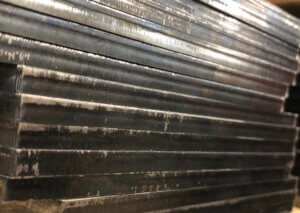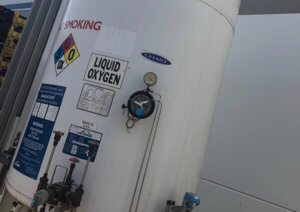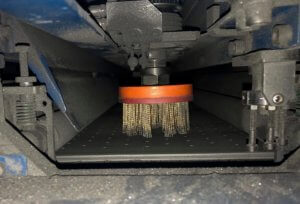Laser Oxide Removal: A Fabricator’s Dilemma
July 25, 2018
 Anyone who cuts steel parts with a CO2 laser and uses oxygen as an assist gas is familiar with the strip (also known as laser oxide) that forms as a result of the process around the contour of the cut. Utilization of oxygen as an assist gas causes an exothermic reaction that creates heat, which helps the laser cut through the metal faster. Unfortunately, it also leaves a strip or film around the cut that has to be removed before the part is painted, coated or delivered to the customer. Why? Because if it remains, it can flake off in its own good time (along with any paint or powder coating), which can be detrimental in automotive or aerospace components. Plus the loss of any coating can open up a part to the deteriorating effects of rust.
Anyone who cuts steel parts with a CO2 laser and uses oxygen as an assist gas is familiar with the strip (also known as laser oxide) that forms as a result of the process around the contour of the cut. Utilization of oxygen as an assist gas causes an exothermic reaction that creates heat, which helps the laser cut through the metal faster. Unfortunately, it also leaves a strip or film around the cut that has to be removed before the part is painted, coated or delivered to the customer. Why? Because if it remains, it can flake off in its own good time (along with any paint or powder coating), which can be detrimental in automotive or aerospace components. Plus the loss of any coating can open up a part to the deteriorating effects of rust.
That’s the reason we focus on 100% laser oxide removal as part of our process. However there is no tried and true method of oxide removal just yet.
 Why Use Oxygen?
Why Use Oxygen?
We could avoid the laser oxide problem completely by using nitrogen as an assist gas on our lasers instead. Nitrogen prevents oxidation and leaves a clean edge that’s ready for welding or painting. The problem is that the cost for nitrogen gas is generally five to six times greater than oxygen, which ultimately gets passed down to the customer. This obviously makes nitrogen cutting significantly more expensive to the end user. Overall, it’s not an ideal choice for most carbon steel cutting jobs, it is preferred when cutting stainless or aluminum however.
The same cost multiplier comes into play with stamping parts. There’s no oxide, but dies are expensive and require significant maintenance over time. So, for now, cost effective and efficient cutting of steel parts for our customers means utilizing oxygen – and putting up with the oxide.
Some Common Removal Practices
What tools do fabrication shops use to eliminate laser oxide? Some have sandblasting equipment. The problem with that method is it only removes oxide from outside edges. It doesn’t always reach into internal features. It can also break the surface condition of the material and cause off gassing when exposed to heat or extreme conditions causing finish imperfections.

Acid baths do an exceptional job on removing laser oxide, especially when dealing with complex parts, and aren’t that expensive, but they are a hazmat nightmare that add their own set of challenges to the equation. The handling of corrosive material from the onset of delivery through its disposal opens a whole new can of worms that fabricators face while trying to rectify the oxide dilemma.
Brushing machines are another popular choice, offering both horizontal and vertical brushing options. But they’re not cheap to maintain and we’ve found they aren’t always effective. The brushes need constant replacement and tend to wear unevenly, so the oxide removal isn’t consistent.
Our One-Two Punch
While not perfect, we still use a series of brushing machines as the first stage in our battle with laser oxide. We have tried a variety of models on the market in an attempt to improve the process and continue to test new products as they become available.
Which leads us to our fail-safe best practice to remove oxide before the part is shipped – human muscle. After a pass through the brushes, our dedicated shop professionals take over to grind, brush and buff any lingering scale away.
Inspect. Inspect. Inspect
While we haven’t discovered any secret formula for easily getting rid of laser oxide, one thing we do have is one of the highest standards in the industry for quality control. So, until the magic solution appears (and fabricators all around the world rejoice), rest assured that we are ever vigilant in our quest to rid our parts of laser oxide.
If you would like to learn more about our laser cutting or other fabrication services, please contact us.



